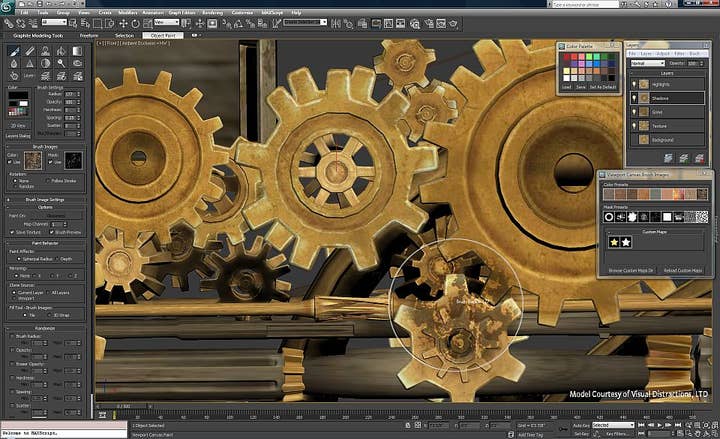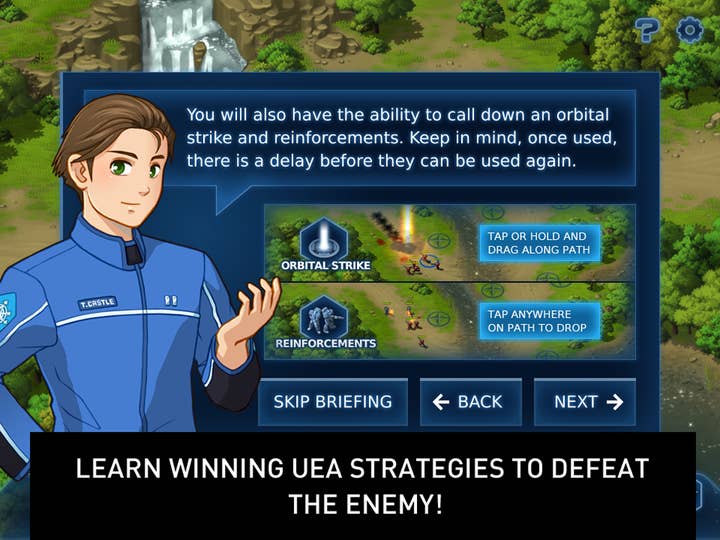Autodesk aims to make tools more affordable and accessible
We speak to the toolmaker about targeting mobile, and tackling the challenge of platform fragmentation
Creating games requires an array of software tools for generating and processing code, artwork, music and everything else that goes into a complete product. While many tools can be found for free, typically game creators have used a variety of commercial software to create games. One of the leaders in such software has been Autodesk.
Autodesk has been providing modeling and animation tools, and more recently UI and middleware tools that have powered the top console games from the big publishers. Products like 3DStudio Max, and SoftImage have been mainstays in the production departments of major publishers. These tools aren't cheap, though; seat licenses run in the thousands of dollars, which has put Autodesk tools beyond the reach of most independent studios and individuals.
That is changing, though, as Autodesk moves to address the fast-growing mobile, web and online game markets. GamesIndustry International recently spoke with Mark Strassman, vice president of Industry Strategy and Marketing for Autodesk's Media and Entertainment industries, and Gregory Castle, senior product marketing manager for gaming, about how Autodesk is adapting to a quickly evolving market.
"There's been a huge democratization of storytelling capabilities," said Strassman. "Mobile devices are everywhere, and most of them have more power than many consoles. Even before we specifically targeted web, mobile and social games markets, we've seen a huge increase in interest in our tools such as 3DS Max and Maya to do modeling, make characters and animate those characters. Trial of those products has been going through the roof, and interest in buying them in a much more accessible way."
"There's been a huge democratization of storytelling capabilities"
Mark Strassman
Strassman points to the fact that mobile developers have a very different budget. "A lot of them are doing this development at home, at night or on the weekends, in small companies, so they've asked for more flexible ways to pay," he noted. "We've actually released a pilot of a 90-day production version of Max and Maya, just a few months ago that we've seen great uptake on mainly for web and mobile games."
Spending thousands of dollars for software doesn't make much sense to small developers trying to build a mobile product that likely will be given away for free. "Especially for experimentation," said Strassman. "A lot of people want to experiment and play, and they may or may not be creating a business. Some people are looking to create experiences, whether it's for marketing or visualizing or education. We're looking at it a very different way than we used to; the market is exploding for creating web, mobile and social games, and to date we've participated mainly on the high end, and we know we need to transform there as well."
Castle brought up the example of Scaleform. "With Scaleform we had a 2D renderer that was used for UI in AAA games, that enabled you to do overlays of HUDs and menus," he said. Autodesk discovered one AAA developer who broke off and then started doing his own mobile games. "He was used to using Scaleform as a 2D renderer, knew that our SDK was cross-platform, and actually started using it as a sole 2D engine for making mobile games," Castle said. "It was completely unintentional. We started to work with this one customer, and other customers started to request it. The price for AAA developers to use it as UI tool was quite high, so we released a version which is $295 per seat per platform to be able to deploy mobile games. We've had over 5,000 people download and trial it, we have over 500 licensees now for the product."

"When we released the Scaleform Mobile SDK we also created an in-house game, Starforce Battlement," said Castle. "It shows off what's possible using the mobile SDK. When you purchase the mobile SDK you also get the game and the source code. It's all part of changing just slightly how we position our products and make things more accessible."
Sometimes you need to lead the marketplace, and sometimes you need to follow the marketplace and be there for the customers with what they need. "I think this trend is not something by any means I could say that Autodesk has led," Castle acknowledged. "There are loads of factors that have contributed to this. We are being reactive in some ways, but we are looking ahead at what's going on with Android-based consoles, with next gen consoles. Our product is a high-priced product, there's no two ways about that, when compared with other 3D packages in the market for mobile developers. What you're seeing now with devices constantly improving their graphic capability, customers more and more want the high-end tools because the graphical fidelity they're getting on these high-end devices is getting to a point where you're surpassing console quality. You want to have models that really look the part, that really look great. So we're starting to see more and more adoption of our tools for mobile products."
"A lot of people are using the 30-day trial to do their production work, and we realized there was a great opportunity to extend that," said Strassman. "In addition to the 90-day production version that we launched, we're looking at a lot of other similar term models to be more like what are customers are expecting."
There's been a lot of concern expressed among developers about the increasing costs of development for next-gen consoles, given the increased resolutions and greater numbers of polygons and better rendering. "I remember last GDC Epic showed off their Elemental demo to show what Unreal Engine 4 could do," Castle said. "It was a phenomenal demo that completely knocked your socks off with what the engine could do with light and effects. It was probably a 45 second clip. What they failed to mention in any of the demos, and what only came out a couple of weeks later, was that it took a team of 16 four months to make that demo. There is no doubt with this next generation of consoles we're going to see that divergence continue, and that chasm grow between AAA and large studios and mobile developers with smaller, more nimble teams."
"When it comes to our plans for the future and what we're working on right now, there's seldom a meeting that takes place where workflow isn't one of the top topics we discuss, and how to make workflow easier and how to increase efficiency," Castle continued. "That's one topic that's in nearly every meeting we have; and the other topic is democratization and how we make our products more accessible."
"Console games are getting deeper, challenges are mounting and costs are rising," said Strassman. "One of the issues is how can we help our customers with their pipeline and solve their problems? And then how can we take what we're doing there and make it affordable and make it approachable by a much broader base?"
"Console games are getting deeper, challenges are mounting and costs are rising"
Mark Strassman
"As there's increased fragmentation and complexity in game development, middleware is something we've seen grow in importance," said Castle. "Two years ago we made an acquisition of a company called Scaleform, which I was a part of. That's probably our most popular tool, and it takes all of the hassle out of creating UI for games. UI is one of those things that when you look at it doesn't seem like it will be a time-consuming part of development, but in actuality it is. Many game developers have three, four or even five people who during the entire development cycle are just working on UI. We have other tools as well, like our lighting tool, an AI tool, and each one of those pieces, when you add it all up it actually turns out to be a significant part of your development budget."
Are developer fears over the cost of next-gen development justified? "I don't know. If you're a PC gamer you're pretty much playing on next-gen hardware as it is," said Castle. "If they're designing for the PC, game developers are already essentially designing on next-gen capabilities. I think it's a bit exaggerated." Strassman points out that "At the same time the console platforms are evolving, so are the development platforms. You can develop on faster computers, you can render faster, you have things like middleware so you don't have to re-solve problems again and again. It's not a problem that we hear from our developers that it's getting more and more complicated."

"I think the biggest differentiating point going forward is fragmentation," said Castle. "I think it's good for a company like Autodesk to be frank because we are the tools provider; it becomes our problem to ensure our products are working cross-platform. Customers will rely more and more on toolsets like us to take care of that cross-platform implementation rather than doing it on their own."
"Where I am seeing more pressure from AAA developers of console games is they're seeing more and more competition from web, mobile, and social," said Strassman. "Over the past couple of quarters you've seen their revenues decline even with new platforms coming out, and they want to differentiate as much as they can from the web and mobile gamer. I think that differentiation is actually really important to them. Whereas they might not have taken advantage of all of a given console's features, I think now they're looking to create a better and deeper experience than you get on a tablet or a phone. I think that's pushing them further as well. They have to keep up with these things."
"We certainly want to serve the high-end customers, but we want to bring that power to the masses as well"
Mark Strassman
"More and more we're seeing different needs from the high end developers and the web and mobile developers, both in terms of features and how they want to purchase products and services from us," said Strassman. "In terms of licensing options, maybe even in terms of feature sets in the future, we'll be serving the two markets differently."
Autodesk now has a range of consumer products as well as its professional products. "We started our consumer business with the thought that everyone out there is creative," said Strassman. "Everyone wants to build and create things. On the physical side of things, you have this whole Maker movement, where you can print things in 3D. I think we'll be seeing a similar movement in the gaming space. I think there will be, and there is, an emerging market for not just playing games but for making games. Individuals can not just make a game from scratch, but start with some content and they're not creating a AAA experience, but to create a compelling game and to tell a gamified story. It's certainly something we're interested in, how we can allow people at all levels to be creative."
What should we be expecting from Autodesk in the next year or two? "We're continuing to focus on an integrated set of tools, with even tighter integration," said Strassman. "Pricing flexibility we think is really important; we came out with this 90-day production version where you don't have to buy a full license, you can buy 90 days at a time. I think you'll see continued flexibility on meeting different users' expectations and willingness to pay. Reaching out to broader platforms, and enable users on the low end of the market to create interactive gamified experiences in a new way. There's a lot going on and it's an exciting time in our market."
"There are some parts which we are reactive to, but it's quite obvious there's a fundamental change that's going on with the market, and we are now staying ahead of the curve," Castle noted. "We're testing on Android-based consoles to make sure all of our products work; whether or not it's Ouya or GameStick, we see that as a really interesting trend. Developers are going to be able to rely on us for compatibility with all of these new different platforms."
Strassman feels that the future is a much broader market than just the established console game makers. "It's not just high-end trained professionals that are going to create entertainment experiences; everyone's going to do it," said Strassman. "At different levels of the market there's going to be different needs, different functionality, and different pricing. We certainly want to serve the high-end customers, but we want to bring that power to the masses as well."

